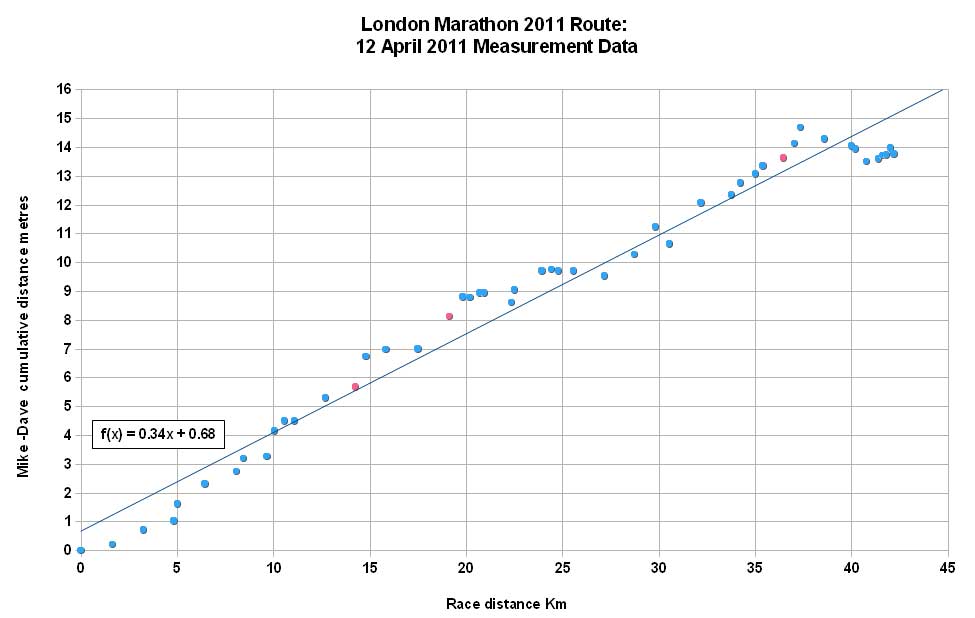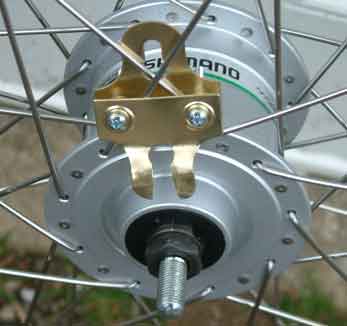Hugh Jones, Dave Cundy and I measured the 2011 London Marathon Course last Monday night/Tuesday morning. For me it it was an interesting trial of my new electric assist bike in two major ways:
- Would I be able to keep up with these two younger and much fitter riders over 26 + miles ?
- Would the electric bike give an accurate result in comparison with two IAAF regional course measurement administrators ?
I am not sure I could devise a tougher trial for electric bike measurements than that!
So here is the story:
At midnight on Monday I met with two international road race course measurers at East Ferry Road on the Isle of Dogs to measure the London Marathon route for this Sunday's race. Hugh Jones, in his mid fifties is a former London Marathon winner and still very slim and fit looking. Dave Cundy who administers course measurement in Asia and Oceana is tough tanned Aussie, also mid fifties I would guess.
I had chosen and purchased my 3 gear Kalkhoff Agattu, with mid engine drive through the chain, precisely to be able to stay with these two fit bike riders while measuring the London Marathon as well for measuring other races that come my way. Especially the hilly ones and those involving more than 15 to 20 miles riding in a day which is about my limit these days.
We had protection from a van and a pickup from a road marking company regularly used by the London Marathon. Usually they were behind us when we were on the "correct" side of the road, but when the shortest line took us onto the "wrong" side, the van with its yellow lights flashing moved ahead to block off any oncoming traffic. I was surprised how much traffic some of the major roads had between midnight and 4.40 am when we completed measuring the route in 6 segments finishing at the end of Westminster Bridge under Big Ben.
We then calibrated again on Rotten Row in Hyde Park, Here is a snap of my two colleagues, standing behind my Agattu which was in pride of place, and admired by them as a good solid bike for measuring.

I chose the bike and its gearing based on the general measurement requirement of 10mph riding for good accuracy. For my general measuring I had decided that three gears in the hub were enough, and I confirmed this in a test ride before I purchased the bike. By choosing a 3 hub gear model rather than an 8 speed hub I could save a few hundred pounds.
However from the start I found that Hugh and Dave on their fast, light racing style bikes could not hold themselves back, and I struggled to keep up as they shot up to 15 mph and even more, and my 23kg pedalec loaded with a pannier bag with 3.5 kg of equipment cut out its assistance as per the electric bike regulations in the EU. It left me providing all the power. I was grateful that all the riding I had done over the past 4 months in preparation for my new bike and this occasion came to my rescue, I did not drift more than 40 metres off the back, and of course when there was any sort of slight uphill and they slowed and my bike's power assist came into its own. I kept on level 2 assist (100%) since I did not want to risk exhausting the battery on max assist.
The three assistance levels available on this bike are + 50%, + 100%, and +200% of the rider's force into the pedals. There is a pedal torque sensor and the electric motors output power is servo'd to that. The power available on the max setting gives one an amazing feeling of powerful legs. It is all extremely natural and the bike is instantly responsive. This is unlike some cheaper hub motor systems some of which have throttle controls and are less responsive as well as being less efficient.
The value of the bike's power was also very noticeable when pulling away from a stop. Including our calibration rides, we stopped about 70 times to take intermediate readings, and each time I hardly had to work to accelerate rapidly while I could see Dave immediately in front of me was working hard on his bike to catch up with Hugh at the front. Also it was not long before I decided to mark Dave quite closely and partly shelter my very upright riding position behind his bulk. I really like the upright riding position now. It is a change from my old push bike, and I did wonder whether I would be less stable and wobble more, but I don't think I do. It is definitely easier to glance over my shoulder, even with a neck that is less flexible than when I was younger. I am not worried about increased air resistance since I have the motor to help me. I shall need to investigate how much the cal constant changes into the wind and with it, and this will depend on the tyre as well as my cross-section for air resistance.
If I had known beforehand that my fellow measurers would be going over 15 mph I think I would have investigated some illegal change of gearing sprockets to give me a higher cut out speed and reduce the cadence. The EU laws specify that the output of the motor must be reduced to zero at and above 25kph = 15.6 mph. But some people fiddle with the sprockets to change that cut-off.
The great thing was that I did not really tire too much and towards the end I was keeping up comfortably - they probably slowed a bit but speeds of 15 mph were still common on my GPS.
The other great thing was that the 25.2volt 18Ah battery easily lasted. In all I did 36 miles, all in medium assist, and the last battery LED was glowing steadily - not flashing. I think I used a little more than 80% of the battery capacity. All the stop-start was a good test of hard riding with lots of traffic lights on city streets. I have no doubt one could reliably get over 40 miles for a hard town commute at my weight of 95kg. Riding more leisurely at 10mph at home I had previously got a range 84 miles to battery cut out.
So that is how the bike performed in enabling me to track these younger riders. Had they kept down to 10 mph it would have been even easier and I might have been able to do it on minimum assist (50%).
But what about our measurements? They all agreed with one another within 14 metres. So I think this ride validates the accuracy of electric bikes for use by course measurers who are Old Age Pensioners (i.e >65 ), to extend duration of their measuring career.
Here is a plot of the difference in accumulated distance between myself and Dave.

I should explain that the the 3 red points are where I had to correct my written down counts for obvious transposition errors: obvious because they produced errors of order 100m or more at these intermediate splits points.
You can see the difference builds up very steadily to 14 m over the marathon. This suggests that it could be due to temperature changes and the greater sensitivity of my fat tyres to the temperature change of 11.7C at precal and 7.2C at Post cal (it was a cool dawn in Hyde Park!). But also variations of constant due to surface roughness may also come into the story. I have not added up the number of turns on the course, But probably slight positioning errors in relation to the correct line 30cm from the kerb on bends would also be contributing. Whatever, this result together with my other test measurements reported earlier in this thread, leads me to conclude that measurements with electric assist bikes can be trusted to give good results. Just remember not to choose a e-bike with a front hub motor. I think that would give very poor results just as it would if you braked using the front wheel brake.





